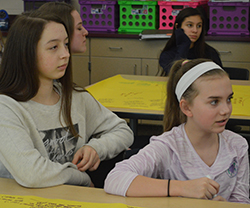A renaissance of reading and writing is going on at West Middle School, where teachers say students are indulging in books they love more than ever and learning a lot, page by page. They regularly peruse eighth-grade English Language Arts teacher Jamie Stevenson’s bookshelves to find a new title and engage in book talks. They’ve even won national writing awards.
Teachers credit a curriculum that includes reading and writing workshops. More than a dozen district teachers received training on the workshop model over the past two summers at the Teachers College Readers and Writers Institute at Columbia University, in New York. The curriculum embraces student choice in reading and writing, and teachers and students say it has revved up enthusiasm in their classrooms.
“The great thing about it is the culture of reading has completely changed,” Stevenson said, noting that many of her students have read 50 or 60 books already this school year. “The volume of reading has gone up ten-fold.”
| Editor’s Note: The Road to Reading series explores some of the reading activities you’ll find in our schools as well as difficulties students may face when learning to read. The series also examines early childhood ties to literacy and new initiatives to help all children read. |
Teacher Jamie Stevenson credits students’ Scholastic Art & Writing Awards to increased enthusiasm for reading and writing. West Middle School’s first-ever winners in writing categories of the the Scholastic Art & Writing Awards include the following:
|
They bring their books with them from class to class, grabbing them after finishing tests and reading, she said. “It’s crazy to see how much some of these kids are reading.”
Seventh grade ELA teacher Christine Gustafson said the amount of reading and writing students are accomplishing now “is exponentially higher than ever before. In addition, the quality of their thinking about their reading and the complexity of their writing has grown as well… We have found that our students commit more to completing books, and some even share great books with their peers, much like adults.”
No More Long Lectures
The workshops unfold like this: Stevenson and other ELA teachers start class with mini-lessons lasting just a few minutes on topics like proper use of colons. They then set students loose — reading, flash-drafting (completing an entire first draft of a paper in class), editing and revising, and discussing books in groups. Students also participate in book discussions online.
“Basically it’s less time of teacher instruction in front of the class and more time in reading and writing,” Stevenson said.
The curriculum is based on the philosophy that students gain the most from books they love. There are no more in-class novels read simultaneously. Shelves filled with books in which the district has invested in recent years offer options for fans of all reading genres, from dystopian to historical fiction.

There’s an excited buzz around helping students find the right books for them, and that has created a “community of readers,” said Principal John Krajewski.
“Teachers challenge their readers to explore a wide variety of genres and read outside of their comfort zones,” he said.
Questions for Discussion
Not only has the volume of reading increased, students are also eager to go in-depth to comprehend what they read.
In Stevenson’s eighth-grade class, students recently worked in book clubs of four members each. They spread big yellow sheets of paper on the tables in front of them, on which Stevenson had placed the same picture on each group’s page: an image of Belle and Beast, from the Disney classic “Beauty and the Beast,” inside a library.
Stevenson challenged them to use whatever book their club was reading to make connections to the picture. For the next 10 minutes, the room was completely silent as students wrote down their thoughts in colorful ink.

Turns out, they could find a lot in common between “Beauty and the Beast” and “Michael Vey” by Richard Paul Evans; “The Book Thief” by Marcus Zusak; “The Running Dream” by Wendelin Van Draanen; and “The Rithmatist” by Brandon Sanderson.
After writing their own thoughts, they commented on one another’s. As they worked, they got closer and closer to the connection Stevenson wanted them to find. “Raise your hand if you have a character in your book that feels out of place, that doesn’t feel like he or she fits in,” she said.
All raised their hands. “Even though we are all reading different books, they all have the same idea,” she said. “They are all based on characters that maybe sometimes don’t feel like they fit in in society. They are different somehow, just like the two characters in the picture in front of you. Both Belle and the Beast feel like they don’t fit in.”

Students said they enjoy the workshop process.
“We talk about the book and stuff we read between the lines,” said eighth-grader Kaylinn Remer. “Then I can understand stuff I didn’t understand before. People see things different, so it makes me look at things different.”
Added Abbie Westers: “It really helps me understand the book more and you can go in depth even more… It’s fun to figure things out with your group and make predictions.”
Arianna Turner had this take: “If you don’t catch something in the book, maybe one of your group members will catch something you missed, so it helps you understand it more.”
CONNECT









